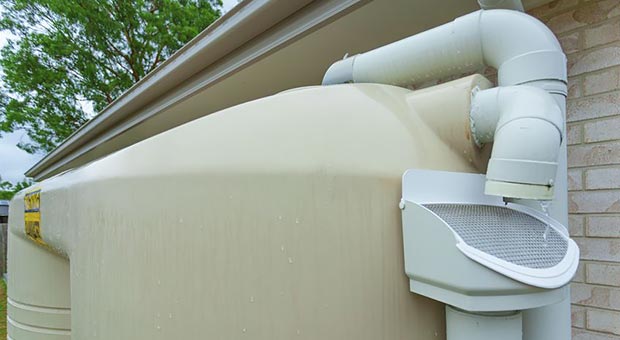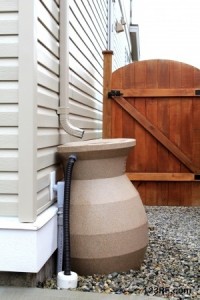Rainwater is an excellent source of free water, or so you’d think, right? Apparently not, though. For example, some Western states including Utah, Washington and Colorado outlawed home owners from collecting rain water on their own properties.
According to the good’ ol government, the water that falls from the skies belongs to someone else and you’re essentially stealing if you collect it. So check your laws before moving forward.
Well, that being said, collecting rain water can be very important for your survival, if SHTF and your regular water supply runs dry. In a societal collapse scenario, don’t expect for the regular chains of supply, i.e. utilities like power, gas or water to work efficiently, if at all. Therefore, survival will be up to you.
A clean and reliable source of water is absolutely critical when it comes to survival. You can last for weeks without food, but without water, you’ll kick the bucket in a matter of days (three-four days tops) and you’ll be non-functional within just a couple of days.
Now you can see how rainwater collection can become a survival issue. In normal times, the average American uses almost 100 gallons of water per day (according to the US Environmental Protection Agency).
In reality, though, you only need just about a gallon to survive if you’re just going to drink it. Plan for another 1-3 gallons for hygiene purposes. Still, that’s a lot of water to save in buckets or gallons if you’re stockpiling for a month or even a week.
Collecting and storing rainwater may sound weird for all of us that are used with wasting water on a daily basis, since water seems to be an abundant resource at the present time. However, if SHTF a rainwater collecting system will be an excellent (and maybe the only) alternative for providing you and your family with good quality water for drinking, cooking, and hygiene.
You can use rain water for various purposes : besides drinking, rainwater can be used for washing your clothes, feeding your live stock and even to flush your toilet.
 Harvesting Rainwater
Harvesting Rainwater
Now, if you choose a dedicated rainwater collecting system, which is very easy and straight forward to build, you can DIY from readily available materials.
Its advantages, besides providing you with a good quality water source, are its simplicity of construction, the ease of maintenance and its convenience.
Though it may sound simple, harvesting rain water is not as simple as putting a bucket under your gutters; things are actually a bit more complicated than that. To begin with, contrary to popular belief, rain water is not as pure as an angel’s tears.
The air is filled with pollutants nowadays, not to mention the filth that lies on your roof (you’ll harvest the rainwater from your roof, generally speaking) : dead bugs, birds feces, dust, arsenic, lead, and a variety of other not-so-delicious toxins accumulate up there and will run right into your bucket along with the rainwater.
Filter it First!
Depending on the type of the roof you have, you must filter the rain water thoroughly. Only if you have a steel/glazed tile roof, you can collect rain water without filtering it. A roof made of asphalt shingles, concrete tiles or galvanized metals will require you to filter the water before storing it in order to remove debris. We recommend filtering it regardless of what type of roof you have.
Aside from the rainwater collecting system, you should also consider investing in a high quality water filtration system. Or you could use natural water purification methods as described in one of our previous articles.
If you already decided to collect rain water directly from the roof, remember to let the rain to wash your roof for 10 minutes before starting to collecting it; that way you will prevent larger debris and at least a layer of contaminants from getting into your water supply.
You should use a screen to capture the larger particles from the water, like leaves and bugs. In the next step, if necessary, you will use a dedicated water filtration system before storing it.
The rainwater should be stored for later use in a 50+ gallon barrel. You don’t need anything fancy: just a regular barrel painted black to minimize algae growth and to block sunlight. In a SHTF situation, it would be a good idea to hide your rain barrel from your neighbors or passersby using trees or plants. Hiding your stockpile from strangers is another article you should check out too.
If you have anything you’d like to add to this information, please feel free to leave a comment below.
This article has been written by Chris Black for Survivopedia.



 Harvesting Rainwater
Harvesting Rainwater





Grandpa69 | April 5, 2014
|
With the advent of Chem-trails, it is essential to your health to SUPER-FILTER as well as treat for bio-hazards ALL water! The charcoal filters impregnated with silver should be sufficient BUT, be aware of the mysterious chemicals that are being deliberately sprayed into our skies daily.
The British Berkfield water filters are a good example of gravity filters that WORK!
Pingback:How to Collect Rainwater for Survival | Ready Chimp | April 5, 2014
|
Tony | April 6, 2014
|
Question about painting the storage tank “black” to prevent algae growth. I would think that black attracts sunlight and would create more heat on the plastic and thus making algae growth more possible than if you say left it at its normal blue color or used camouflage colors to blend with your home.
Great Grey | May 6, 2014
|
Painting it black is to stop the light that the algae needs to grow. That doesn’t mean you can’t paint some other color over the black. Also depending on were it is, it could get the water hot enough to kill bacteria.
Pingback:Prep Blog Review: How to Build Your Water Reserve | SurvivoPedia | April 7, 2014
|
Pingback:How to Collect Rainwater for Survival | Prepper Chimp | April 13, 2014
|
Pingback:Make the Most Out of Water in Your Home | SurvivoPedia | August 17, 2014
|
Jane | January 29, 2015
|
The rules changed around July of 2013. I searched and found out that in Utah you can register to collect your own rainwater off your roof or in other ways. Our home is registered in my name and our cabin in my husband’s name. It was a free service and requests how much you want to collect and gives you various amounts to sign up for. Going with the largest amount makes the most sense. Nice to know we can use our own rainwater again. Hope this gives some hope and options to others.
Pingback:How To Calculate Your Water Needs | Survival skills, survival guns, survival guide | May 15, 2015
|
Pingback:How To Calculate Your Water Needsdisasterdefense.us | disasterdefense.us | May 15, 2015
|
Pingback:How Much Water DO YOU NEED to Survive? • Survival Atlas – The Trusted Source for Everything Survival | May 16, 2015
|
Pingback:How To Calculate Your Water Needs | September 14, 2015
|
Pingback:The Basic List For Your EMP Survival | Wichita Observer | November 23, 2015
|
Pingback:Off-Grid Mechanics: 8 Steps That You Need To Know | Prepper's Survival Homestead | May 20, 2016
|
Pingback:How Many Ways Can You Build A Water Container? | Prepper's Survival Homestead | July 8, 2016
|
Pingback:How Many Ways Can You Build A Water Container? | | disasterdefense.us | July 8, 2016
|
Pingback:8 Survival Hacks Using Plastic Wrap | Survivopedia | December 2, 2016
|
Pingback:How Many Ways Can You Build A Water Container? | Survivopedia | February 20, 2018
|